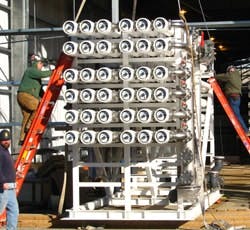From Shortage to Surplus
The residents of Brockton, Mass., can enter this summer without restrictions to water their lawns and gardens. This is a big deal because Brockton is transitioning from watering bans to a water surplus, ending a century-long water shortage. The industrialized and densely populated suburbs in the Boston area continue to grow, which has put a strain on the aquifer that has thus far supplied groundwater for municipal drinking water. To end the shortage once and for all, Brockton has embraced desalination, installing the first large-scale desalination plant in New England.
A Challenging Task
The development of a desalination facility makes it possible for Brockton to supplement the existing groundwater sources with lower-quality surface water from the Taunton River. Tides carry ocean water far inland along the river, so the water must be desalted.
To resolve quality issues, Inima USA was awarded a design-build-operate contract to provide a regional desalination plant. Kansas-based Layne Christensen Co. (www.layne.com) provided reverse osmosis (RO) equipment and related services. After extensive pilot testing of the pretreatment and RO, and long discussions about the intake and brine discharge processes, a desalination solution was accepted by the community and the Massachusetts Department of Environmental Protection. This was no small task considering that this is the first large facility of its kind in New England.
Building for the Future
The RO skids were designed by Layne Christensen Co. (www.layne.com) and built at Layne’s 40,000-sq-ft Lakeland fabrication facility. The system is comprised of three skids, each with an initial flow of 1.1 million gal per day (mgd) using a 24 to 12 single pass array. The membrane treatment plant was designed with expansion in mind. By adding pressure vessels and membranes, the future build-out potential is 2 mgd each using a 36 to 12 array.
Due to their large size, skids were built in two pieces for shipping purposes. They were then bolted together on site. Each unit was provided with a local control panel that communicates via Ethernet to the master control panel to eliminate the need for field wiring. Layne's comprehensive services provided membrane installation and startup. Remote monitoring of the system performance via the Internet was made available as part of the overall service support structure that Layne (www.layne.com) provides in addition to local and regional service technicians and membrane process experts if they should be required.
Fourteen miles inland, on the west bank of the river, the newly constructed Taunton River Desalination Plant will have an initial capacity of 5 mgd, expandable to 10 mgd. Not only does Brockton have ample water to satisfy its needs for the foreseeable future, it has a sellable surplus for surrounding communities, making future growth and development possible.
Lisa Culbert is marketing manager for Layne Christensen Co. Culbert can be reached at [email protected] or 602.345.8559.
